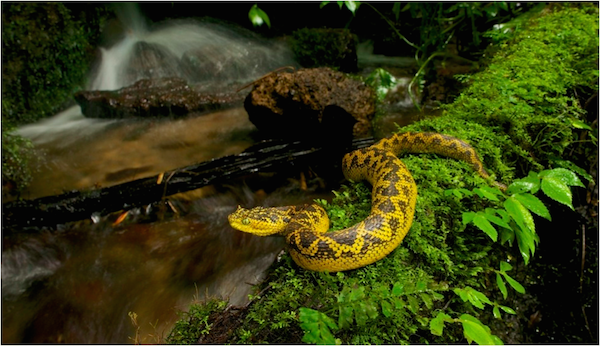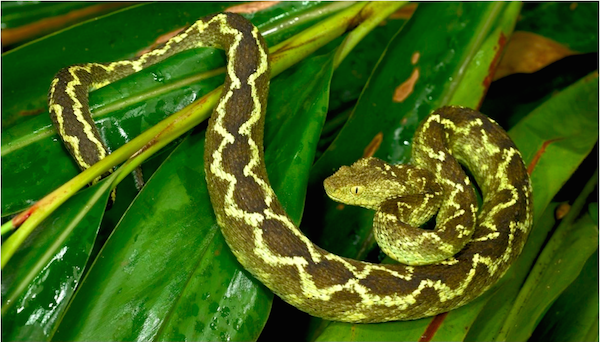A recent study examines the evolution of viper species in East Africa, highlighting the region’s mountaintop forests as among the most biodiverse in the world and calling for their protection.

Atheris ceratophora enjoys a snack. Photo by Michele Menegon.
East Africa is famous for its dry savannahs, sparse woodlands, and its “Big Five” animals: elephants, buffalo, lions, leopards, and rhinos. Lesser known are its lush mountains that speckle the grasslands and desert from Mozambique to Ethiopia. These isolated habitats are home to a plethora of species, and are considered by scientists to be some of the most biodiverse regions in the world. However, their forests are being cut down for farmland and are threatened by global warming, putting at risk multitudes of species that have nowhere else to go.
East Africa’s climate is heavily influenced by the Great Rift Valley, a gigantic trench stretching 6,000 kilometers (3,700 miles) from western Asia down through eastern Africa. It started forming millions of years ago as the two major tectonic plates that comprise Africa started drifting away from one another, and continues to widen to this day, “rifting” at an average rate of an inch per year. In addition to creating a valley, this rifting process caused the uplifting of mountains along its sides, which dry out the air that passes over them from the east. The rift also created lake basins that are sensitive to “climate pulses,” sometimes filling with water and sometimes emptying in response to changes in Earth’s orbit. Over millions of years, the gradual shift of East Africa from rainforest to dry savannah punctuated with climatic hiccups influenced the evolution of many species, including our own.

The bottom of the Rift Valley in East Africa. Rifting and mountain uplift abruptly changed East African climate and landscape, generating new challenges for fauna dispersal and survival. Photo by Michele Menegon.
During the climatic upheavals of East Africa, its mountaintop forests remained relatively stable and moist, acting as oases for many species. Today, they are hotbeds of biodiversity. For instance, the Eastern Arc Mountains, which span eastern Tanzania and extend a bit up into Kenya, have some of the highest concentrations of endemic plants and animals in the world. To study how climatic and geologic processes influence the evolution of animal life, researchers from around the world focused on the Atheris genus of vipers, a group comprised of 15 species in East Africa, many of which are endemic. Their study was recently published in the journal Molecular Phytogenetics and Evolution.
The researchers compared genetic sequences of species found in the region, with their results indicating all diverged from a common ancestor in the west between 15 and 18 million years ago; around seven million years ago. Then, around seven million years ago, the vipers radiated east when the region was more forested. More species arose as the region dried and snakes became confined to the mountains and unable to interbreed. This led to some unique evolutionary trajectories.

Rainforest habitat, as it was across most of Africa during Atheris early radiation in Miocene and the present day habitat of most of the Atheris species. Photo by Michele Menegon.

Atheris barbouri, an extremely rare and poorly know viper, also a late arrival of East Africa. Photo by Michele Menegon.
“All but one Atheris species are arboreal snakes, with long muscular body and prehensile tails, probably ambushing preys while sitting on branches,” co-author Michele Menegon told mongabay.com. “Atheris barbouri is an interesting anomaly probably, again, due to changes in local climate at the time of its diversification. It lives in the leaf litter and, despite being closely related to arboreal species, it lost the elongated body and the prehensile tail, typical of the other species, and became a terrestrial, short and stout small viper, probably feeding on terrestrial arthropods.
Because of their naturally fragmented habitat, many Atheris vipers are restricted to tiny habitats. One has been found only in a game reserve in Uganda, another on two isolated mountains in northern Mozambique.
“The most recently described species, Atheris matildae, is known only from a tiny fragment of forest in southern Tanzania, the locality is kept secret by scientists to avoid illegal harvesting– given the popularity of vipers in pet trade,” Menegon said, adding that viper range sizes in general are still poorly understood.

Atheris matildae, a recently discovered species in the Livingstone Mountains of Tanzania. Photo by Michele Menegon.
Surprisingly, the Eastern Arc Mountains, while being one of the oldest ranges in the region, has some of the youngest Atheris species. The researchers suggest this may be because the range simply wasn’t colonized by vipers until relatively recently. This resulted in a C-shaped movement to Atheris evolution, with the Eastern Arcs representing the last stop for the snakes.
The Eastern Arc Mountains are also one of the vipers’ last refuges, with lowland forest disappearing at a quick rate. Already naturally fragmented and scattered due to the region’s climate – only higher elevations are cool and moist enough to support forests – the mountains’ rainforests are being deforested away evermore by clearing of forest primarily for farmland. According to data from Global Forest Watch, the area comprising these mountains lost 179,000 hectares of forest from 2001 through 2012—even in places demarcated as Protected Areas.

The Eastern Arc Mountains are the site of the las radiation of Atheris viper species. The region has lost 179,000 hectares since 2001. Map courtesy of Global Forest Watch. Click to enlarge.

Even Mikumi National Park is not immune to deforestation, with sub-montane forest cleared for farmland within park boundaries. Map courtesy of Global Forest Watch. Click to enlarge.
According to Menegon, direct forest clearing will likely be exacerbated by global warming. As carbon emissions crank up atmospheric temperatures worldwide, the oases at the tops of the rift mountains will be especially vulnerable, and their wildlife that evolved to live in a cool, wet climate will have nowhere else to go.
Surprisingly, collection for the exotic animal trade is another big threat to these vipers. Because who wouldn’t want a pet that lies in wait at face-level to strike with teeth filled with deadly venom to which there is no known antidote?
“Not much is known about Atheris venom except that it is strongly hemotoxic, causing pain, swelling, and blood clotting problems,” Menegon said. “There are a number of reports of bites that have led to severe hemorrhaging and at least one case was fatal. An antivenin specific for an Atheris bite does not exist.”

Atheris nitschei. Photo by Michele Menegon.
But if these species naturally evolved amidst upheavals that changed their habitat, can’t they cope with the changes facing them today? According to Menegon, the answer is no. The climatic shifts brought about by the formation of the rift happened on a geologic time scale of thousands to millions of years. Today, changes are happening much more rapidly, at a rate that does not allow a grace period for evolution—only decline and extinction.
“Today the main threat is habitat destruction and in specific cases, individual over-collection for the pet market. Range restricted species could be brought to the brink of extinction in few decades by the combination of these two factors,” Menegon said. “Many species of Atheris are montane cold-adapted organisms and they tend to escape rising temperatures by altitudinal range shifts. Given that they often occur in isolated forest remnants at, or close mountain summits, altitudinal range shifts due to climate change could represent a real threat on a long-term perspective.
“It will be difficult to resolve such a problem, and the creation of ex-situ conservation strategies such as translocation to other suitable sites might be the only solution.”

Atheris rungweensis. Photo by Michele Menegon.
Citations:
Dimitrov, D., Nogués-Bravo, D., & Scharff, N. (2012). Why do tropical mountains support exceptionally high biodiversity? The Eastern Arc Mountains and the drivers of Saintpaulia diversity. PloS one, 7(11), e48908.
Hansen, M. C., P. V. Potapov, R. Moore, M. Hancher, S. A. Turubanova, A. Tyukavina, D. Thau, S. V. Stehman, S. J. Goetz, T. R. Loveland, A. Kommareddy, A. Egorov, L. Chini, C. O. Justice, and J. R. G. Townshend. 2013. “Hansen/UMD/Google/USGS/NASA Tree Cover Loss and Gain Area.” University of Maryland, Google, USGS, and NASA. Accessed through Global Forest Watch on Dec. 03, 2014. www.globalforestwatch.org.
Maslin, M. A., Brierley, C. M., Milner, A. M., Shultz, S., Trauth, M. H., & Wilson, K. E. (2014). East African climate pulses and early human evolution.Quaternary Science Reviews, 101, 1-17.
Menegon, M., Loader, S. P., Marsden, S. J., Branch, W. R., Davenport, T. R. B., & Ursenbacher, S. (2014). The genus< i> Atheris(Serpentes: Viperidae) in East Africa: Phylogeny and the role of rifting and climate in shaping the current pattern of species diversity. Molecular phylogenetics and evolution, 79, 12-22.Related articles
Meet the world’s rarest chameleon: Chapman’s pygmy

(11/25/2014) In just two forest patches may dwell a tiny, little-known chameleon that researchers have dubbed the world’s most endangered. Chapman’s pygmy chameleon from Malawi hasn’t been seen in 16 years. In that time, its habitat has been whittled down to an area about the size of just 100 American football fields.
Chameleon crisis: extinction threatens 36% of world’s chameleons

(11/24/2014) Chameleons are an unmistakable family of wonderfully bizarre reptiles. They sport long, shooting tongues; oddly-shaped horns or crests; and a prehensile tail like a monkey’s. But, chameleons are most known for their astonishing ability to change the color of their skin. Now, a update of the IUCN Red List finds that this unique group is facing a crisis that could send dozens of chameleons, if not more, to extinction.
Poor rains then floods lead to food crisis in Somalia
(11/11/2014) Four years after over a quarter of a million people perished in a famine in Somalia, the East African country is again on the verge of a possible humanitarian disaster. Flooding in southern Somalia, following months of little rain, has just exacerbated an already-precarious situation according to the Food and Agricultural Organization (FAO).
Corruption in Tanzania facilitates ivory trade
(11/06/2014) Corruption in Tanzania is enabling large volumes of illegal elephant ivory to be smuggled out of the country, alleges a new report from the Environmental Investigation Agency (EIA).
Four countries pledge to restore 30 million hectares of degraded lands at UN Summit
(09/25/2014) In 2011, Germany and the International Union for the Conservation of Nature launched the Bonn Challenge, which pledged to restore 150 million hectares of degraded and deforested lands by 2020. Several countries have already made commitments—including the U.S.—but this week at the UN Climate Summit four more jumped on board.
Google Earth spurs discovery of a ‘new’ chameleon species

(08/17/2014) Google Earth has spurred the discovery of another new species. In this case, the creature is a pygmy chameleon, one of four previously unknown Rhampholeon chameleon species described from the remote ‘sky islands’ in Mozambique. The Mount Mabu pygmy chameleon was discovered after Google Earth images of a tract of forest led Julian Bayliss to launch a scientific expedition to the region.
U.S should sanction Mozambique for its role in elephant, rhino poaching, urges NGOs
(07/03/2014) Two prominent NGOs U.S should sanction Mozambique for its role in elephant, rhino poaching, urges NGOsare petitioning the U.S government to slap Mozambique with trade sanctions due to the country’s role in regional poaching. The groups contend that Mozambique has done little to combat both its own poaching epidemic or stop its nationals from spilling over the border to kill rhinos and elephants in South Africa and Tanzania.
A taste for wildlife: what’s driving bushmeat hunting in Tanzania?

(06/25/2014) Barbed-wire snares, spent shotgun shells, the lingering smell of gunpowder, and strips of curing meat: glimpses from a bushmeat hunt. Bushmeat hunting is the illegal hunting of wildlife for food and income. A new study reports regular bushmeat consumption by a large proportion of Tanzania’s tribal populations. Co-authors Silvia Ceppi and Martin Nielson were hunting for their own answers: who was eating bushmeat and why?







